
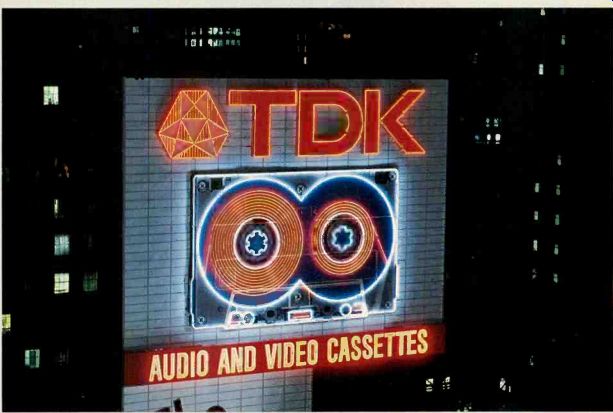
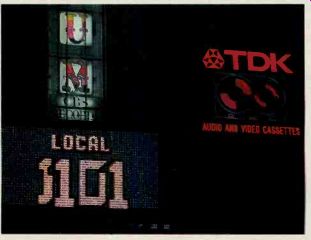
Nothing about the products of a manufacturing company is ever really accidental. To the contrary, anything a firm designs and builds is, metaphorically speaking, a mirror of sorts and reflects the image of the company that created it. While the products TDK Corporation is best known for, magnetic audio and video recording tape; are specifically designed for near-perfect reproduction of sounds and images, even before the magnetic impulses that translate to words, musical tones and pictures are imprinted on TDK tape, each cassette can be said to contain a wealth of thought and energy. This is because each is endowed with the collective intelligence and philosophy of the many dedicated people responsible for the creation of TDK products.
The Deception of Little Things
There is something deceptively simple about an audio cassette. Perhaps it is the minute size, or the fact that parts constructed to such, critical tolerances are housed in an enclosure which the user can safely handle as casually as he or she can a pack of chewing gum.
Look a bit deeper, however, and it is easy to see why, before TDK introduced the first high fidelity cassette in 1968, audio experts were virtually unanimous in doubting that genuine high fidelity performance could be attained from this medium, originally intended for use in dictation.
Looking closely at a TDK cassette, however, can take one only part way down the road to understanding it.
More information is necessary, including facts relating to the company's history, its key executives and corporate philosophy as well as technical data.
For this reason, TDK Corporation, the world's leading producer of magnetic tape, is taking the occasion of the medium's 50th anniversary to present readers of AUDIO magazine with a company portrait. It is sincerely hoped that the understanding it conveys will enhance the enjoyment you derive from TDK products.
===============
Yasuo Imaoka: The Father of Avilyn
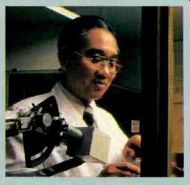
Much of the credit for the technical leadership that TDK has achieved belongs to Dr. Yasuo Imaoka, Executive Director and General Manager of Research and Development. Dr. Imaoka is known in the electronics industry as "the Father of Avilyn," the magnetic material composing the particles that are the heart of TDK recording tape.
"We are continually interested in upgrading," Dr. Imaoka declares.
"This means producing new products which satisfy the needs of the consumer and which assist in upgrading overall industry standards.
Our research and development efforts are directed to finding ways of overcoming the limitations of existing materials and translating the results into products that can be manufactured on a commercial scale." "A position of leadership demands that we lead in all areas," asserts this internationally-known authority on magnetics. To this end, he points out, TDK devoted about one half the company's R&D budget of $49.8 million in the last fiscal year to magnetic recording media.
=================
Some Facts About TDK

TDK (the initials stand for Tokyo Denki Kagaku Kogyo) was founded in 1935, the year following the invention of magnetic recording tape. The company's founders, Dr. Yogoro Kato and Dr. Takeo Takei, were scientists striving to commercially harness what was then a revolutionary magnetic material called ferrite.
Because ferrite powder can be sintered into a variety of shapes, it proved an ideal core material for radio transformers, but the radio industry was only the first to benefit from TDK's expertise in ferrite technology. It wasn't long before the material was widely utilized among consumer electronics manufacturers. Today the products that contain ferrite, of which TDK is the world's largest producer, include countless audio and video recording heads, speaker magnets, transformers, bar antennas and more. In fact, the firm now fabricates some 75 per cent of all rotary transformers used in the video cylinder heads for video cassette recorders.
TDK's role in the development of magnetic tape is of parallel importance.
The firm unveiled its first recording tape in 1952 and, in 1966, introduced the cassette format to Japan. Two years later, TDK won worldwide recognition by developing the first audio cassette to achieve true high fidelity performance.
Designated SD, this groundbreaking formulation is the ancestor of today's TDK cassettes, singled out by nearly 60 per cent of the world's leading audio cassette deck manufacturers as their reference standard normal bias, high bias and metal tapes.
TDK Corporation is now a multinational corporation with stock traded on exchanges throughout the world, including the New York Stock Exchange.
In addition to manufacturing in several Japanese facilities, the company now operates two plants in the U.S. The TDK factory in Peachtree City, Georgia, concentrates on videotape production while audio cassettes for the American market are assembled and loaded in a facility in Irvine, California.
In the fiscal year ending November 30, 1983, TDK's sales of magnetic recording tape reached 5755.3 million; accounting for just over 50 per cent of the company's total sales of a billion and a half dollars. These are substantial numbers, and numbers are crucial in arty business. Top executives at TDK, however, prefer to view the company as a microcosm of the world itself-and the primary ingredient of our world, of course, remains its people.
TDK HX-S:
The tape for Audio's Digital Age

The people, the philosophy, the procedures that fuel growth at TDK are also prime contributors to each technological advance at the company. In audio tape, TDK's most recent giant step forward is a formulation known as HX-S. This is the first metal particle formulation designed expressly to record in the Type II (high bias, 70 microsecond) position. HX-S is a remarkable tape which fills a special niche in the marketplace by providing audiophiles a formulation keyed to the special demands of digital recording.
Moreover, it allows recordists to avail themselves of the advantages of metal tape whether or not their decks are equipped with a bias position designed for conventional metal formulations.
Until now, the chief problem in recording from digital source material has been the inability of the tape to store the enormous levels of high frequency energy. TDK HX-S eliminates this problem; it excels in its retention of highs and offers a maximum output level (MOL) in this frequency range that is unmatched by other cassette formulations. In addition, its sensitivity in other parts of the frequency spectrum exceeds or matches the best high bias formulations.
The unmatched MOL and exceptional high-end response of HX-S cassettes allow them effortlessly to handle the wide dynamic range and substantial treble energy of Compact Discs and digitally recorded material. Specifically, HX-S can record a 4 dB higher signal level at 10 kHz than the best of Type II cassettes (such as TDK's own SA). High frequency overload and saturation cease to be a problem. And as a bonus, there is also a 2 dB improvement in midrange energy storage.
Available now in 60 and 90-minute lengths, TDK HX-S is backed by a full lifetime warranty.
=============
The Importance of Avilyn
Super Avilyn's high-density storage capabilities and excellent reproduction characteristics are largely responsible for the advanced state of audio and video recording technology today. TDK announced the discovery of Avilyn in November, 1973. An amalgam of two highly combustible substances, gamma ferrite and metal cobalt particles, Avilyn proved ideal as an alternative to the expensive and scarce chromium dioxide formulation; this indicated, as has since been proven, that it would set precedents in audio recording. Video recording was seen as an other important application of the substance.
Shortly after Avilyn's introduction, TDK engineers combined cobalt hydroxide in lieu of metal cobalt with its ferrite base to produce an improved material known as Super Avilyn.
The Super Avilyn formulation first appeared in a standard audio cassette in 1975. Known simply as SA, this became the world's first non-chrome high bias audio cassette. In 1981, TDK produced a dual-layer audio tape called SA-X, which became its flagship high bias tape, and in 1982 the firm introduced a special Avilyn formulation, the first to be incorporated in a normal bias cassette. This achieved higher density and higher coercivity in the normal bias position.
=============
EHG HiFi and HD-Pro: TDK Upgrades its video tapes to meet a changing market
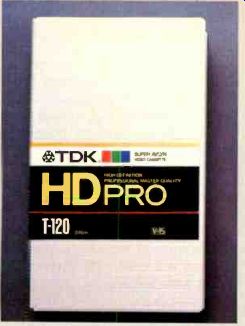
--------- Back in the early 1970's, TDK stepped beyond the existing formulations that existed in audio tape at that time-most notably the chromium dioxide particle-to produce Avilyn, a magnetic particle consisting of cobalt ions adsorbed (coated) on finely milled, needle-shaped, gamma ferric oxide particles. These early developments in fine particle technology laid the groundwork for breakthroughs in today's new wave of high fidelity VCRs. The first of these breakthrough formulations, dubbed TDK EHG Hi-Fi, benefits the videophile who wants to be certain that lifelike video images are coupled with high quality stereo sound.
The second breakthrough tape, HD Pro, is the closest thing the connoisseur video tapist can get to 1/4-inch resolution in half-inch format-a tape which is ideal for live camera recordings, dubbing, special effects work and other pro or semi-pro applications.
Critical Performance
-----
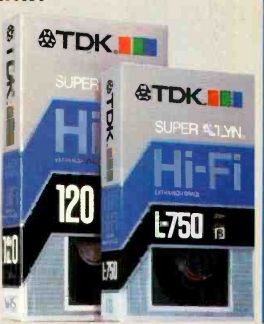
Both EHG Hi-Fi and HD-Pro share certain technical similarities which enable each to offer visually better results than their competition. TDK accomplished this by further refining Super Avlilyn particles so that they are not ice ably shorter, thinner and more uniform than particles used in other tapes'. This means the tape particles can be packed together more densely to produce better sound and video. In HD-Pro's case, the particles are so fine that they can be packed together 12 times more densely than TDK's own Standard tape. Designed to meet the needs of today's unerringly precise VCRs. TDK's EHG Hi-Fi delivers exceptional picture quality and dynamic sound-even after hundreds of plays. Signal-to-noise ratio is up 4.5 dB in luminance and 5 dB in chrominance over TDK's Standard video tape. This means razor-sharp definition, extra bright colors and extra detailing and shading even in black and white. EHG Hi-Fi also offers cleaner, more natural sound with improved frequency response and sensitivity up 1 dB over Standard TDK tape.
The second tape, HD-Pro, is without question the highest definition half-inch video tape on the market, boasting unequalled freedom from dropouts. And if you don't believe us, testing experts at Asahi Camera in Japan agreed, placing TDK well above its competition in this respect.
Digital Audio Recording A good video tape has wide and remarkably uniform response over a Megahertz bandwidth, low noise relative to the signal recordable and reasonable freedom from dropouts (random losses of signal as a result, usually, of physical imperfections in the tape coating). Digital recording on video tape doesn't care about bandwidth and low noise, but is profoundly disturbed by dropouts. Dropouts in digital audio are heard, and it sufficient in duration can sound as violent as the deepest sort of record scratch. The digital world has learned, as did Asahi Camera's tape testers, that not all video tapes are equal.
Digital usability has become a byproduct of TDK's meticulous attention to physical integrity and the uniformity of the cassettes coming off its line.
Both HD-Pro and EGH Hi-Fi reflect this careful attention to quality and detail. Remember, however, that these tapes are still the best video tapes you can buy, with features such as a precision-made "SQ" shell mechanism built to tolerance 2.5 times industry standards, a high conductivity back coating, and ultra-smooth base film, contributing to the smoothest running performers on the market.
So whether you are a videophile whose needs are met by TDK's EHG Hi-Fi or a master "pro'' recordist who demands the sophisticated HD-Pro you'll welcome the benefits of these recent developments. Just visit your favorite retailer and pick out a few to try on your own VCR.
==================
The Tape Production Triangle
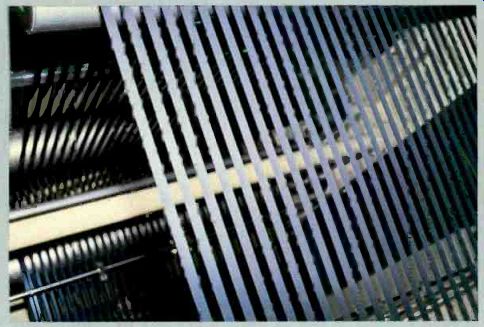
There are three essential elements of tape manufacturing that can be seen as an equilateral triangle. One need only envision the magnetic materials as the triangle's base with one side consisting of shell and component parts and the other the manufacturing processes by which these parts are combined to become a unified whole. During production, members of the TDK family constantly strive for improved techniques. In addition, the newest in automated machinery assists these TDK employees in the quest for perfection.
There is a phrase that has become a byword on the TDK production line; it is "total productivity maintenance." In keeping with this admirable philosophy, workers set out to learn as much as possible about the machines they monitor, attempting to understand what makes them malfunction when they do and establishing routines for preventive maintenance. Through such efforts, the overall operating efficiency of production machinery-and ultimately the entire plant-is upgraded.
Naturally, quality assurance is a key consideration at each stage of production-from materials manufacture and product design through preproduction and manufacturing. The process includes environmental testing, endurance and shelf life tests.
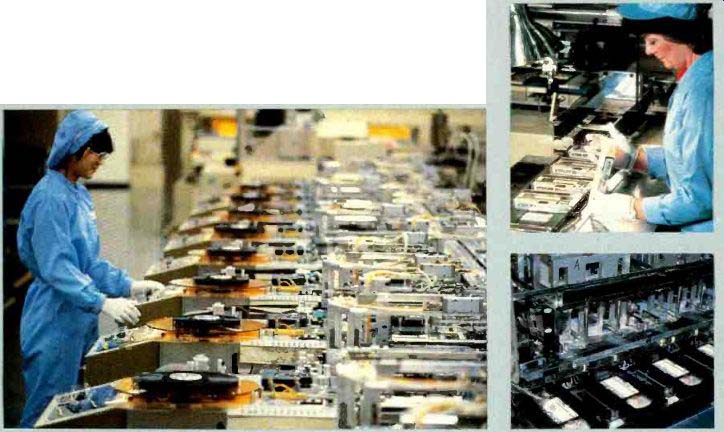
Visitors to TDK's Chikumagawa plant, the company's largest and the facility producing the audio tape pancakes to be sent en to the Irvine factory for slitting and loading into cassette shells, are fascinated by row upon row of audio cassette decks.
These, along with a battery of VCR's, run round the clock for testing purposes. Such usage imposes undue strain on this hardware, and an average of 100 new machines per month are required at Chikumagawa.
In addition to their quality assurance functions, the audio and video decks at the plant serve as emblems of TDK's concern with hardware development. The company works hand in hand with the leading deck suppliers to keep current with developments in tape related hardware, and information relating to product evaluation is exchanged on a regular basis.
===============
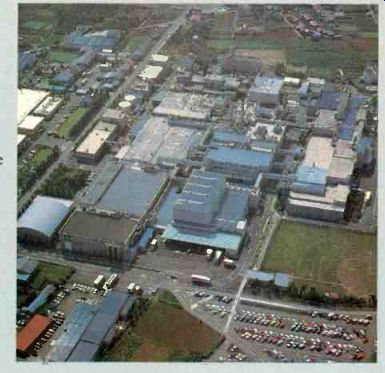
===============
TDK: Some Historical Highlights
1935-TDK is established to begin production of ferrite cores.
1951-Ceramic capacitor production begins.
1952-Magnetic tape production commences.
1960-Barium ferrite magnetic material is introduced.
1966-Cassette tape introduced to Japan.
1968-SD, the world's first hi-fi audio cassette formulation, debuts.
1973-Avilyn unveiled.
1975-SA Super Avilyn audio cassette introduced.
1979-Metal audio cassette tape debuts.
1984 HX-S audio cassette, world's first high bias metal formulation, unveiled.
=============
Future Perfect
While it is gratifying for members of the TDK family to look back on a proud history spanning nearly half a century, it is the primary responsibility of the firm's top executives to look ahead. Continuing leadership in electronics is the goal at TDK, and to achieve it a full 3.5 per cent of the company's revenues are earmarked for research and development. The money is being invested in five R&D departments scattered throughout the firm's production facilities and to a new Magnetic Tape Technical Center located near the Chikumagawa plant.
"Many of TDK's products, including tapes, heads and other components are connected with recording technology." concludes Yutaka Otoshi; TDK's President and a company veteran of 47 years. "The next generation of recording media will be optical, and TDK has already produced prototypes of both DRAW (direct read after writing) and erasable-recordable optical discs. In the months and years to come, we will be considering using our skills to develop a number of advanced products related to this technology, but each and every one of these would have to be unique and reflect the full measure of TDK's creativity."
================
The TDK Professional Reference Series
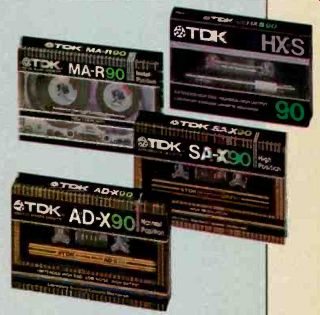


Represents the highest level of achievement in recording tape technology. Each tape sets a standard for sonic excellence. That's why they're the choice of the most discriminating audiophiles. (Includes MA-R and HX-S.)
The TDK Reference Standard Series
Provides outstanding premium quality for a wide variety of recording needs. Each cassette is a product of TDK's advanced tape technology, and offers maximum reliability, performance and value.
All TDK audio cassettes come with a Lifetime Warranty, backed by almost 50 years of magnetic media technology and experience.
TDK's diverse product line also includes an impressive group of tape-related accessories, designed and built with the same stringent standards that have made TDK the world leader in magnetic tape technology.
SA reigns as the finest high-bias position reference tape.
Used by numerous deck manufacturers in high-bias calibration, SA provides a feeling of presence and realism with its extended flat frequency response, high MOL and greater recording headroom, which contribute to better balance, placement, and definition in stereo reproduction. SA features the Laboratory Standard Mechanism for smooth tape transport and trouble-free operation. Avail. in 60 and 90 minute lengths.
MA features the same metal particle formulation as our famous MA-R cassette which sets the Type IV standard for most deck manufacturers. Program sources over the entire audible frequency range, including peaks and high speed transients, can be faithfully stored and clearly reproduced, thanks to MA's superior headroom, frequency response and sensitivity. MA is encased in TDK's Laboratory Standard Mechanism which assures long term reliability and sonic performance. Available in 60 and 90 minute lengths.
MA-R is generally recognized as the Type IV industry standard and is used by most major deck manufacturers to set their metal bias position. MA-R's metal particle formulation has extremely high coercivity and remanence for superior high frequency MOL and low distortion. Its unique TDK engineered Reference Standard Mechanism features a precision die-cast metal alloy frame affording the highest possible accuracy in tape travel and performance. MA-R is the optimum energy-packed performance tape designed to maintain excellence over long periods of time. Available in 60 and 90 min. lengths.
(Adapted from Audio magazine, Aug. 1984 )
Also see:
TDK Electronics -- blank audio cassette tape (ad, Nov. 1978)
= = = =